Annual Patrons of the Arts in the Vatican Museums Meeting Washington Dc
News & Events
The Patrons of the Arts in the Vatican Museums 2021 Annual Blackness Tie Dinner was a not bad success! His Excellency, Archbishop Christophe Pierre, graciously hosted the Washington DC Chapter at the Apostolic Nunciature. Being our first gathering since 2019, all were eager to over again savour each other'south company.
The evening kicked off with a festive cocktail hr and concluded with a sumptuous three-course repast held in the Nunciature's grand Dining Room. During dessert, PAVM International Director, Fr. Kevin Lixey, Fifty.C., gave an update on the Vatican Museums later struggling through Covid. In closing, Fr. Lixey presented former longtime Chapter Leaders, CEM & Judy Martin, with a limited edition impress of the Vatican Museums forth with a thanks letter of the alphabet from museum director, Barbara Yatta. We are all extremely grateful to the xix-years of service that CEM & Judy donated to the Patrons.
Please Click Here to see pictures of this wonderful event!
On July 1, the Museum of the Bible invited the Washington Patrons to a private VIP preview tour of the exhibition, Magna Carta: Justice. Liberty. The exhibition features the Hereford Cathedral Magna Carta, the King'south Writ sent from Runnymede Field in 1215, and the Sandwich Magna Carta, seen by Thomas Paine in 1759, amongst other important documents and historic artifacts.
After the bout, at that place was a reception with the officials from Hereford Cathedral, the British Diplomatic mission, the exhibition curators, and other special guests.
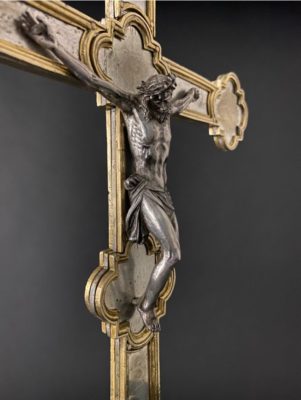
We are proud to denote the completion of our restoration project, the Croce Astile, a Tuscan crucifix which was sponsored by the Washington, DC Chapter. Thanks to your generosity, beautiful artifacts similar this will remain a vibrant instance of the beauty and artistry of the Vatican Museums.
Terminal Restoration Study
The Croce Astile is role of the Baroque drove which became role of the Vatican Museums collection in 2007, thanks to the donation of Carlo and Lucia Barocchi. The piece of work is the fruit of Tuscan silversmiths. According to the data that we have, it would seem that the cross, the crucifix, and the graft with the globe vest to different periods.
The cross is made of gilded-plated, silver-plated copper blend. What differentiates this piece of work from the most common processional crosses is the lack of a wooden supporting element, replaced past a canvas of silvery-plated copper alloy with the ends of the two orthogonal poly-lobed artillery.
An iron bayonet, welded to the lower end of the longer arm, in turn, is in the socket of the silver element. The x gold frames, five on each side, give volume and importance to the cross and the riveted pins adhere the two faces of the bearing plate.
On the front of the cross is the figure of Christ, realized in silver and of excellent workmanship. At the top is a traditional whorl and in the lower function above the poly-lobed tile is a skull. On the dorsum there are no inserted figures. The laboratory only noticed the presence of a claw in the upper part.
The Intervention
The objective of the restoration targeted the removal of the night areas that comprehend the greater part of the work. In detail, these areas embrace the light of the modest model of the realization of Christ finely realized by expert hands.
After the preliminary documentation of the cross, restorers moved on to the disassembly of all elective elements. In order to practice this, it was necessary to remove the one-time metal pins that held the parts together. Restorers so used polar solvents, such as acetone and ethyl alcohol, to remove the old protective layer and the layer of organic substances.
They removed the brown patina, probably composed of silvery sulfides, by means of complexing agents and a mechanical action with micronized calcium carbonate and demineralized water. The degree of hardness of this product prevented in-depth action and therefore fully respected the patina of the silver. The laser welder (Mark-uno 7500) restored the discrete parts. At the end of the cleaning process, all the parts were thoroughly rinsed with demineralized h2o. Then a aridity procedure took place and the usual procedures followed.
At the end of the restoration intervention, there was an application of protective film (ZAPON in acetone 30% p/p) to keep the surface's tone, low-cal, and brightness as long as possible.
In the substitution of the old pins in metal, removed during the phases of the disassembly of the work, the laboratory realized through 3D software that the new pins are from two elements. After being molded in castable resin, the pins are of copper alloy casting.
This new assemblage organisation is important because information technology does non require a deconstruction of the cantankerous, which volition be helpful for eventual new restoration interventions in the time to come.
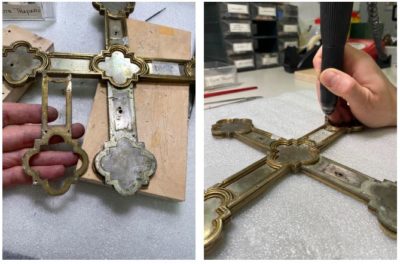
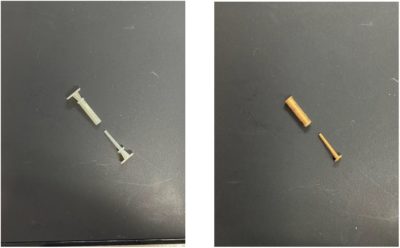
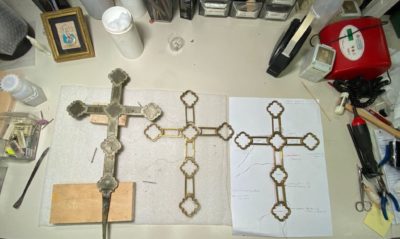
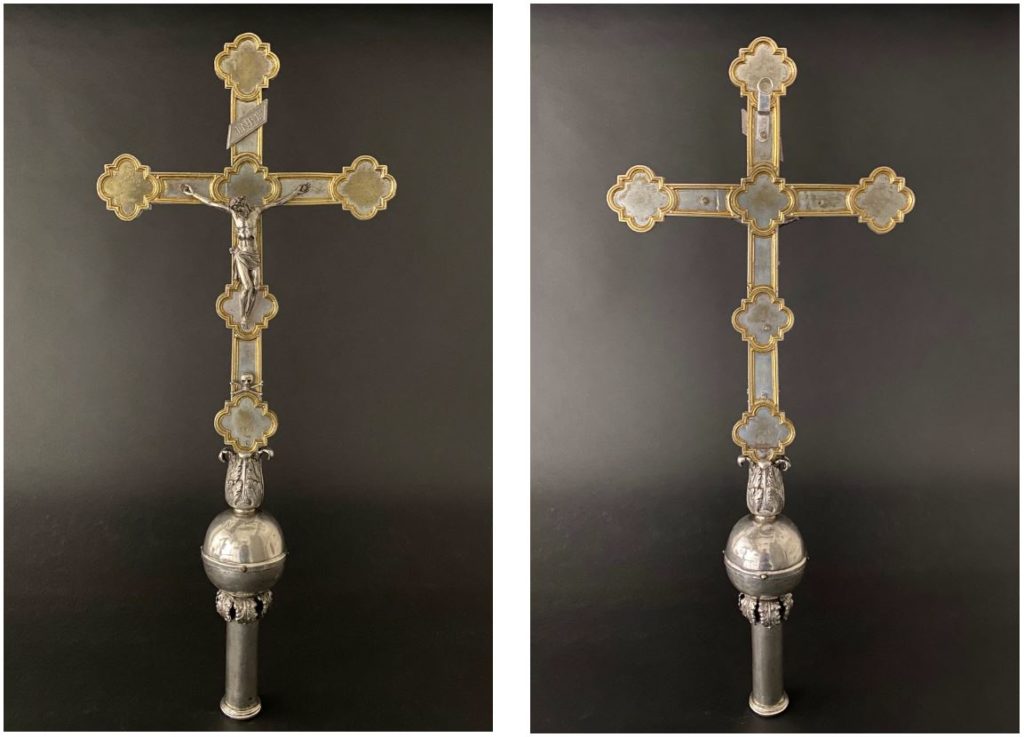

Please join us on a four semester journey of faith and beauty that will take you lot backside the scenes to explore the history of provenance, patronage, and restoration of the Vatican Museums collection equally never before recounted past the Curators themselves.
| This four semester Insiders Course will explore four overarching themes: Each monthly module includes: Information technology is possible to annals for: ●The Beginning Two Semesters (Oct 2020 – May 2021) ●Commencement Semester (October 2020 – January 2021) Deadline for Registration: October xiv, 2020 *Upon the completion of the four semesters, a special Vatican certificate will be earned. More information tin can be found on the Insiders Course brochure (download PDF) and our website patronsvaticanmuseums.org |
ASTILE CROSS
The Lath of Directors of the DC Patrons is proud to announce the adoption of a new project for 2020: The Astile Cross. Your generous donations, by existence members of the Patrons of the Arts, has made the restoration of this antiquity possible.
The Astile Cantankerous is part of a collection of xxx-7 objects – including processional and altar crosses, altar cards, chalices, monstrances, incense boat, holy water fonts – contributed to Carlo Barocchi's generous personal gift to Pope Bridegroom 16.
Sold by the Pope to the Vatican Museums (June 2007), the precious silvers enrich the drove of the Decorative Arts Department. From the moment of the conquering, the department prepared an inventory, accurate photographic campaign and the revision of the conservation condition of all the artifacts, including a structural verification, cleaning and restoration interventions.
The processional cross in embossed silverish and gilded copper (Tuscan silversmith, XV century?), with crucifix in silver fusion (XVIII century) and polylobed elements without decoration, is i of the ancient liturgical furnishings of the Carlo and Lucia Barocchi Collection (Florence).
Father Lixey and his staff take been working hard to keep the Patrons informed and engaged during this world-broad crisis.
Although, nosotros as Patrons, cannot physically go to Rome and visit the Museums or engage in any local Patron activities, Begetter Lixey and the New York Chapter have created a 4-week virtual lecture series available to our Patrons, "Raphael and His World," led by Professor Elizabeth Lev.
If you are interested, delight encounter the PDF in this link for details of the Zoom meeting. Nosotros hope you can join us in this wonderful lecture serial!
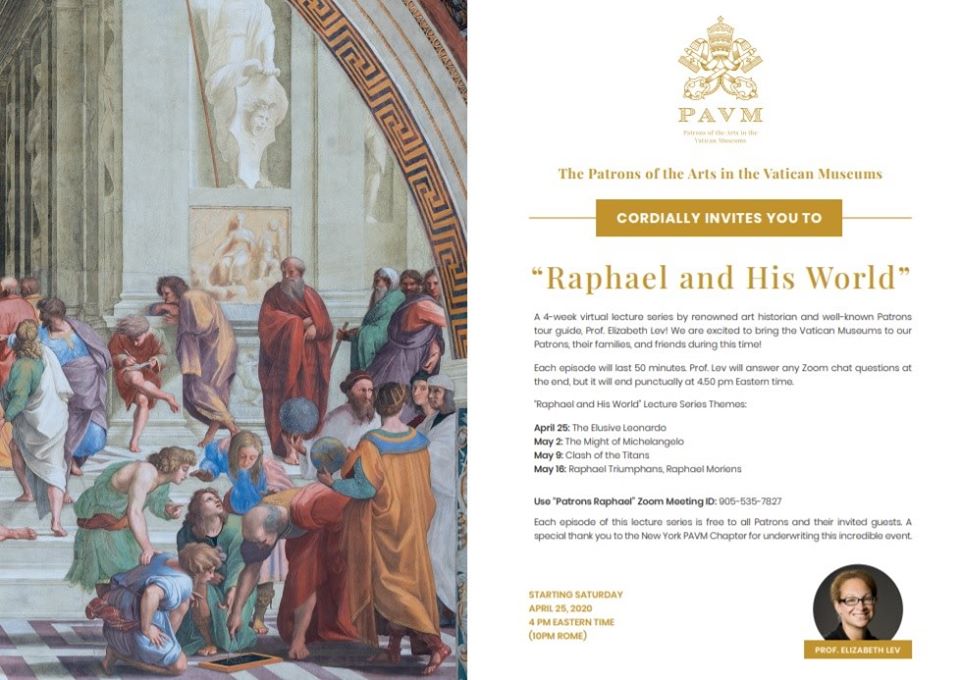
We are pleased to denote the completion of our current restoration project! The wonderful statues and objects in the Chiaramonti Gallery Wall XIV have regained their beauty and splendor thanks to the generosity of our Chapter.
The works of fine art were treated with cleaning methods aimed at the specific type of trouble. Hither are some pictures of the restoration process and the final upshot:
On Sunday, December viii, the DC Patrons held a local event with a VIP Tour of the Bible Museum in Washington, DC.
The tour was highlighted with the unveiling of a sculpture created by Timothy Schmalz entitled "Silent Night". Tim focuses on religious figures and also has many public pieces. One was recently installed at St. Peter'due south Basilica in Rome and another at St. Matthew'southward Basilica in Washington, DC.
The bout continued with a visit to the exhibit Inventors of the Alphabets from the Vatican Library. This is the first time they have been displayed outside the Vatican Walls.
Our side by side end was The Tapestry of Light: Intersection of Illumination. This showroom shows a contemporary glow-in-the-dark tapestry of epic calibration using the Book of Revelation for inspiration. This unusual piece of work of art was created by creative person Dr. Irene Barberis over a period of 20 years.
A new exhibit is The Picture Books of the Past, a collection of paintings from the 14th to 19th century. The medieval Church building used pictures as a tool to convey Bible stories. The curator did an outstanding chore of pointing out key images enabling the viewer to "read" and empathize the paintings.
Following a cursory coffee break, our twenty-four hours concluded with a visit to Washington Revelations, an heady 4 minute "flight" through the Nation's upper-case letter pointing out the Bible's influence on American Culture.
The Bible Museum is located at 400 4th Street, SW, and welcomes all denominations and all who believe in the Bible.
Please come across the Bible Museum Prototype Gallery for pictures of our wonderful tour.
The Patron's Annual Dinner was held December 7th at the Churchly Nunciature, graciously hosted by His Excellency, Archbishop Christophe Pierre.
The evening began with a delightful cocktail party and a chance to reconnect with old friends and brand new ones.
CEM Martin welcomed everyone, including special guests:
His Excellency, Apostolic Nuncio, Archbishop Pierre, and
Begetter Kevin Lixey, International Director of the Patrons of the Arts in the Vatican Museums.
His Excellency welcomed our group and had kind remarks for our patronage to the Vatican.
The slate of officers for 2020 was proposed to the group and they were unanimously canonical:
President: CEM Martin
Vice President: Art Lohsen
Secretary: Judy Martin
Treasurer: Ron Marchessault
After a lovely three-course meal, nosotros were inspired by remarks made past Father Lixey, explaining the importance of the Patrons to the Vatican Museums and the crucial function they play in the restoration and preservation of the endless treasures in the Vatican. There is so much that has been achieved, simply the long list continues for many years to come! Therefore it is very important that we continue to fulfill our mission with our members.
President, CEM Martin, encouraged the members to consider serving on committees or the Lath, to go more involved, and to aid us to grow our chapter in the coming year.
Judy Martin presented the 2020 Chapter Trip to Rome and invited anybody, including family and friends, to consider joining the trip in May. The deadline for reservations is January 30, 2020. Please see the website for details.
Cheers to everyone who attended! It was a wonderful evening and we were delighted to share it with y'all.
Please run across the Annual Dinner 2019 Image Gallery for some pictures of the event!
Source: http://washingtonpatrons.org/news-events/
0 Response to "Annual Patrons of the Arts in the Vatican Museums Meeting Washington Dc"
Enregistrer un commentaire